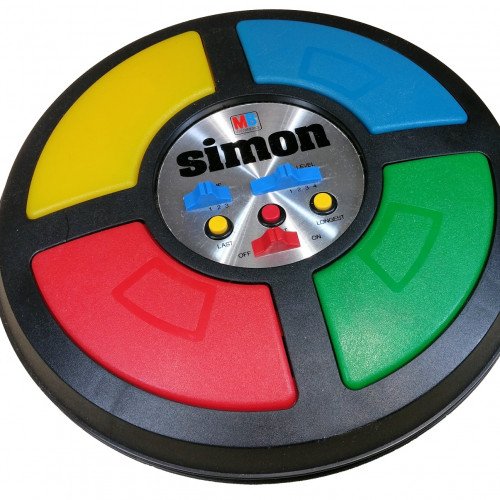HEX VS SIMON

HEX
Hex is a two player abstract strategy board game in which players attempt to connect opposite sides of a hexagonal board. Hex was invented by mathematician and poet Piet Hein in 1942 and independently by John Nash in 1948. It is traditionally played on an 11×11 rhombus board, although 13×13 and 19×19 boards are also popular. Each player is assigned a pair of opposite sides of the board which they must try to connect by taking turns placing a stone of their color onto any empty space. Once placed, the stones are unable to be moved or removed. A player wins when they successfully connect their sides together through a chain of adjacent stones. Draws are impossible in Hex due to the topology of the game board. The game has deep strategy, sharp tactics and a profound mathematical underpinning related to the Brouwer fixed-point theorem. The game was first marketed as a board game in Denmark under the name Con-tac-tix, and Parker Brothers marketed a version of it in 1952 called Hex; they are no longer in production. Hex can also be played with paper and pencil on hexagonally ruled graph paper. Hex-related research is current in the areas of topology, graph and matroid theory, combinatorics, game theory and artificial intelligence.
Statistics for this Xoptio

SIMON
Simon is an electronic game of memory skill invented by Ralph H. Baer and Howard J. Morrison, working for toy design firm Marvin Glass and Associates, with software programming by Lenny Cope. The device creates a series of tones and lights and requires a user to repeat the sequence. If the user succeeds, the series becomes progressively longer and more complex. Once the user fails or the time limit runs out, the game is over. The original version was manufactured and distributed by Milton Bradley and later by Hasbro after it took over Milton Bradley. Much of the assembly language code was written by Charles Kapps, who taught computer science at Temple University and also wrote one of the first books on the theory of computer programming. Simon was launched in 1978 at Studio 54 in New York City and was an immediate success, becoming a pop culture symbol of the 1970s and 1980s. Ralph H. Baer and Howard J. Morrison were introduced to Atari's arcade game Touch Me at the Music Operators of America (MOA) trade show in 1976. Baer said of the product, "Nice gameplay. Terrible execution. Visually boring. Miserable, rasping sounds." The prototype built by Baer used the low cost Texas Instruments TMS 1000 microcontroller chip, which was in many games of the 1970s. Lenny Cope, who was one of Ralph H. Baer's partners, programmed the core of the game, titled Follow Me at the time. Baer developed the tones of the game, inspired by the notes of a bugle. When they pitched the demo, an 8-by-8-inch console, to the Milton Bradley Company the name of the game was changed to Simon. Simon debuted in 1978 at a retail price of $24.95 (equivalent to $98 in 2019) and became one of the top-selling toys that Christmas. U.S. Patent 4,207,087: "Microcomputer controlled game", was granted in 1980. Milton Bradley soon capitalized on the original with both the smaller-sized Pocket Simon and the expanded, eight-button Super Simon. Many variants of Simon have been made since Hasbro acquired Milton Bradley in the 1980s, building on the possibilities offered by advances in technology. The original Super Simon was reinvented in the late 1990s as a hexagonal unit with six buttons. 2000 saw Simon Squared (or Simon2), a unit with the four traditional buttons on one side, and a set of eight smaller buttons on the other. In 2004, Hasbro released the Simon Stix. The game features two electronic sticks (modeled after drumsticks), an emphasis on the musical part of the game, and features four levels of play. In 2005, Hasbro released Simon Trickster (also known as Simon Tricks in Europe and in the UK, and as Simon Genius in Brazil), which features four game modes, in a similar fashion to another Hasbro game, Bop It, and colored lenses instead of buttons. "Simon Classic" mode plays up to 35 tones(notes). "Simon Bounce" is similar to "Simon Classic", but instead the colors of the lenses change. "Simon Surprise" is one of the most difficult games in the unit. Every lens becomes the same color and the player has to memorize the location. "Simon Rewind" requires the player to memorize the sequence backwards. During each game, the player is paid a compliment after a certain number of tones completed. On reaching five and eleven tones, the computer will randomly choose "Awesome!", "Nice!", "Sweet!" or "Respect!". On reaching 18 tones, the game will play a victory melody three times. On reaching the ultimate 35 tones, the game will play the victory melody again and will say "Respect!". If the player fails to memorize the pattern or fails to press the right color within the time limit, the game will play a crashing sound and the game will say "Later!".